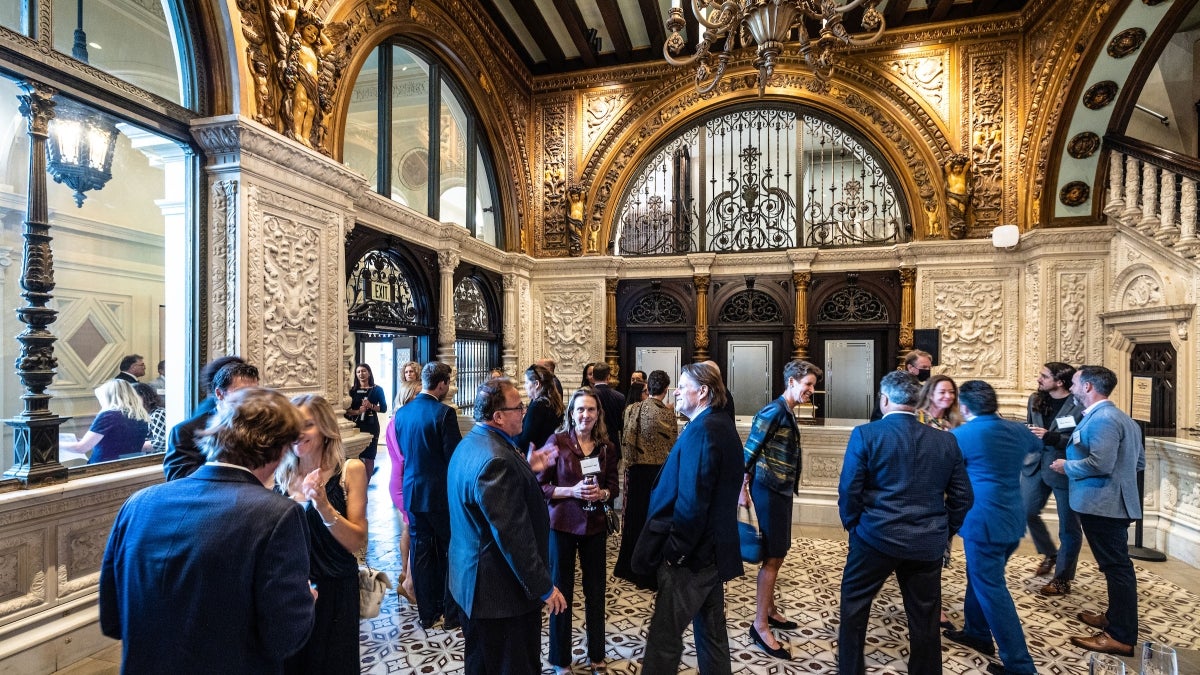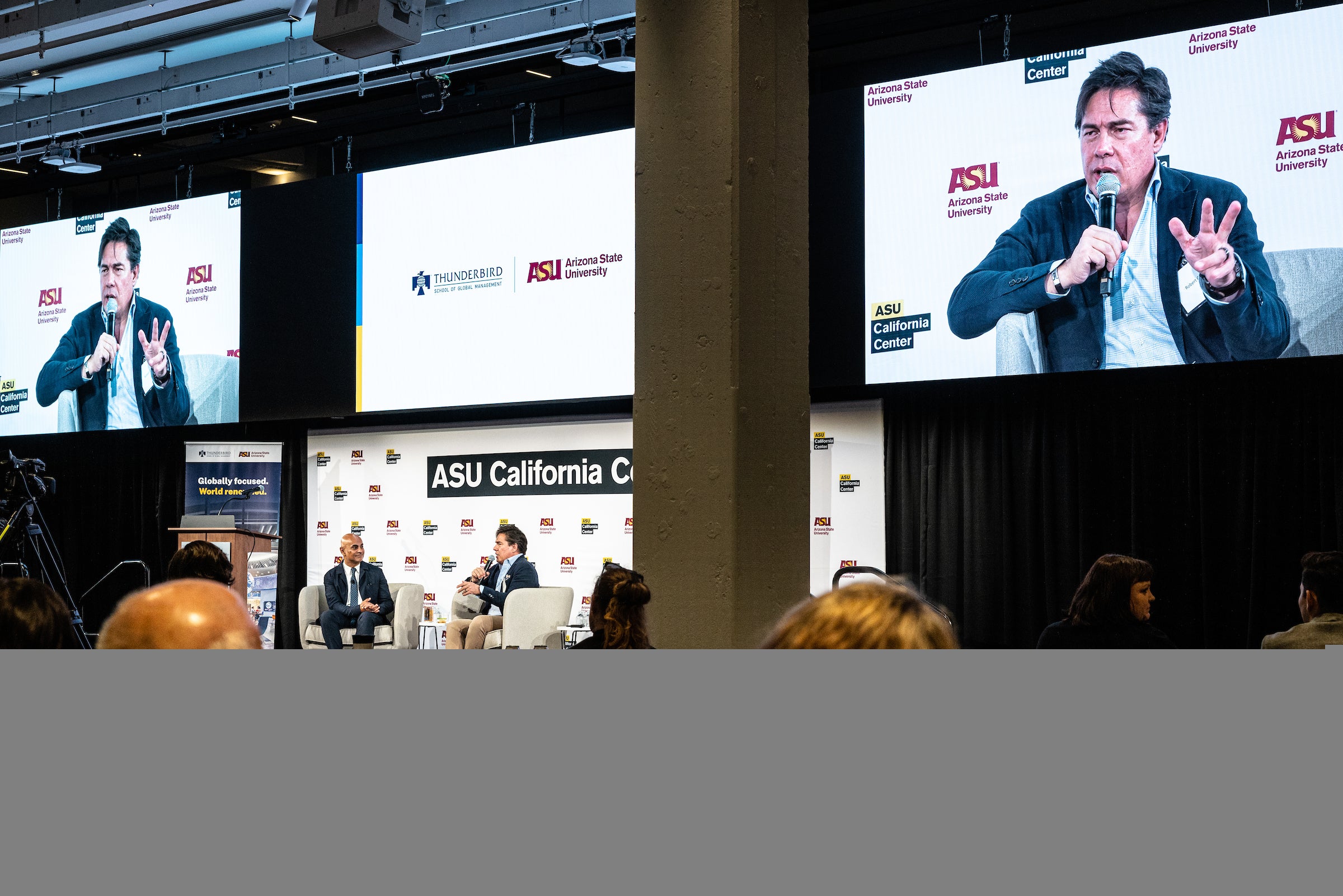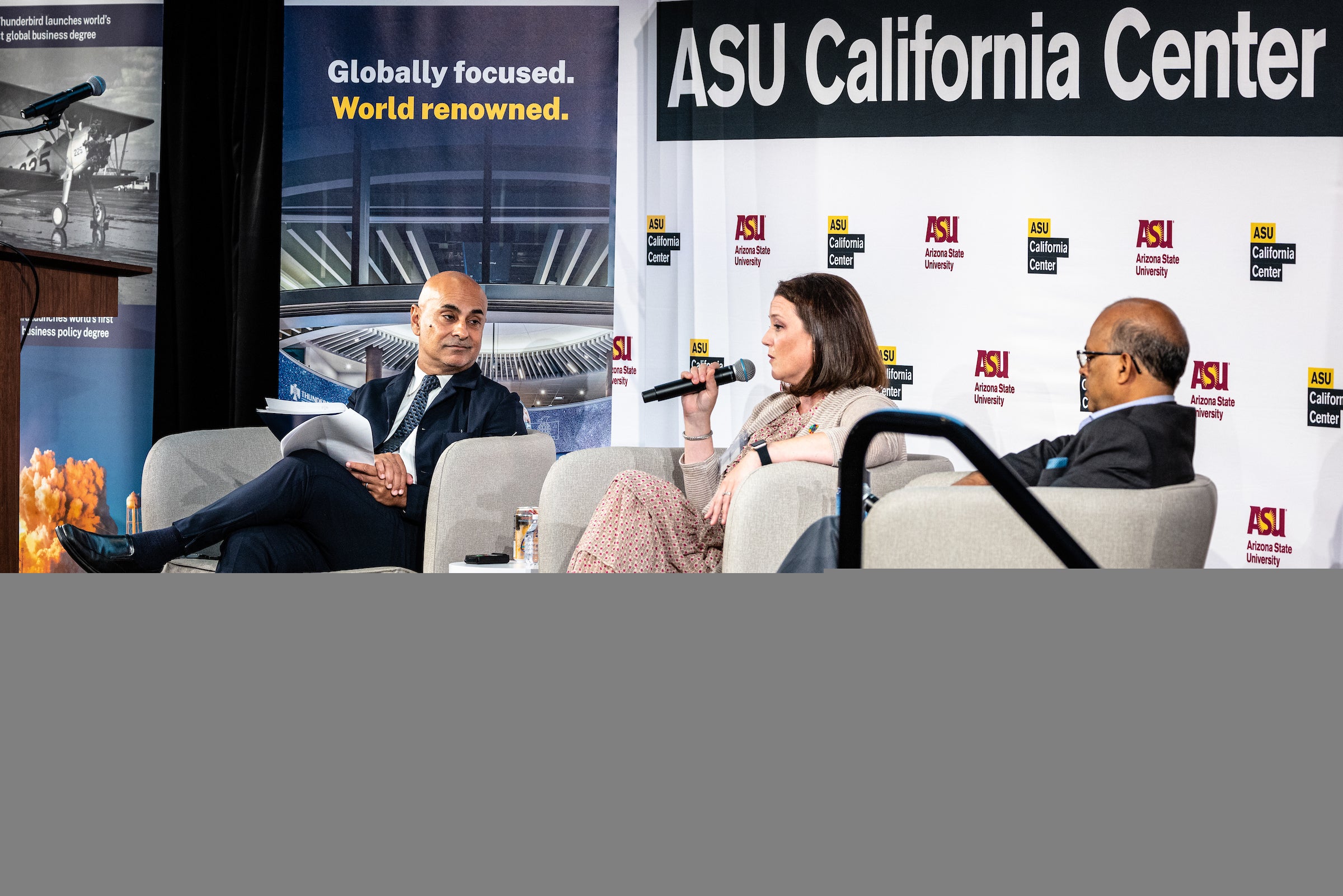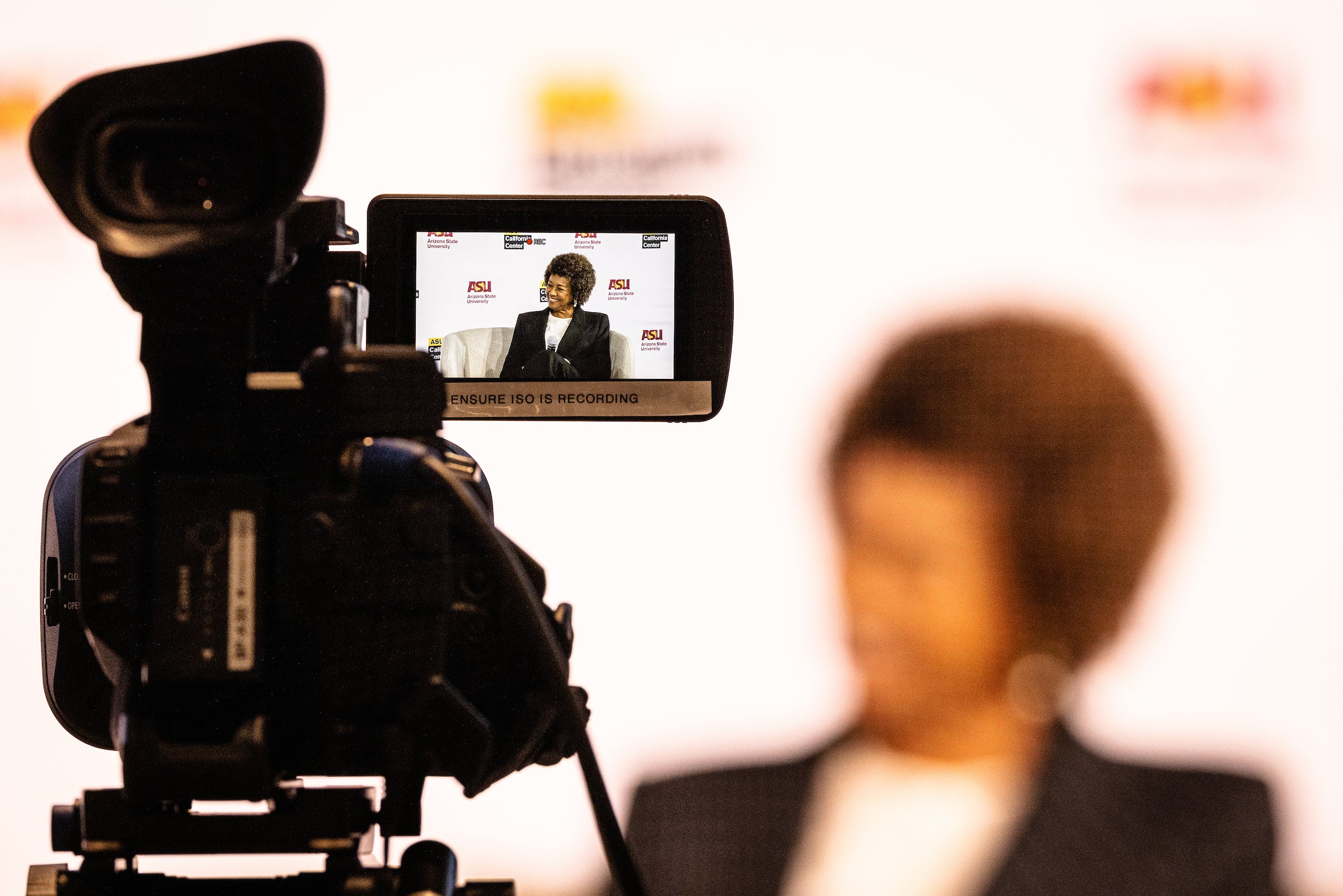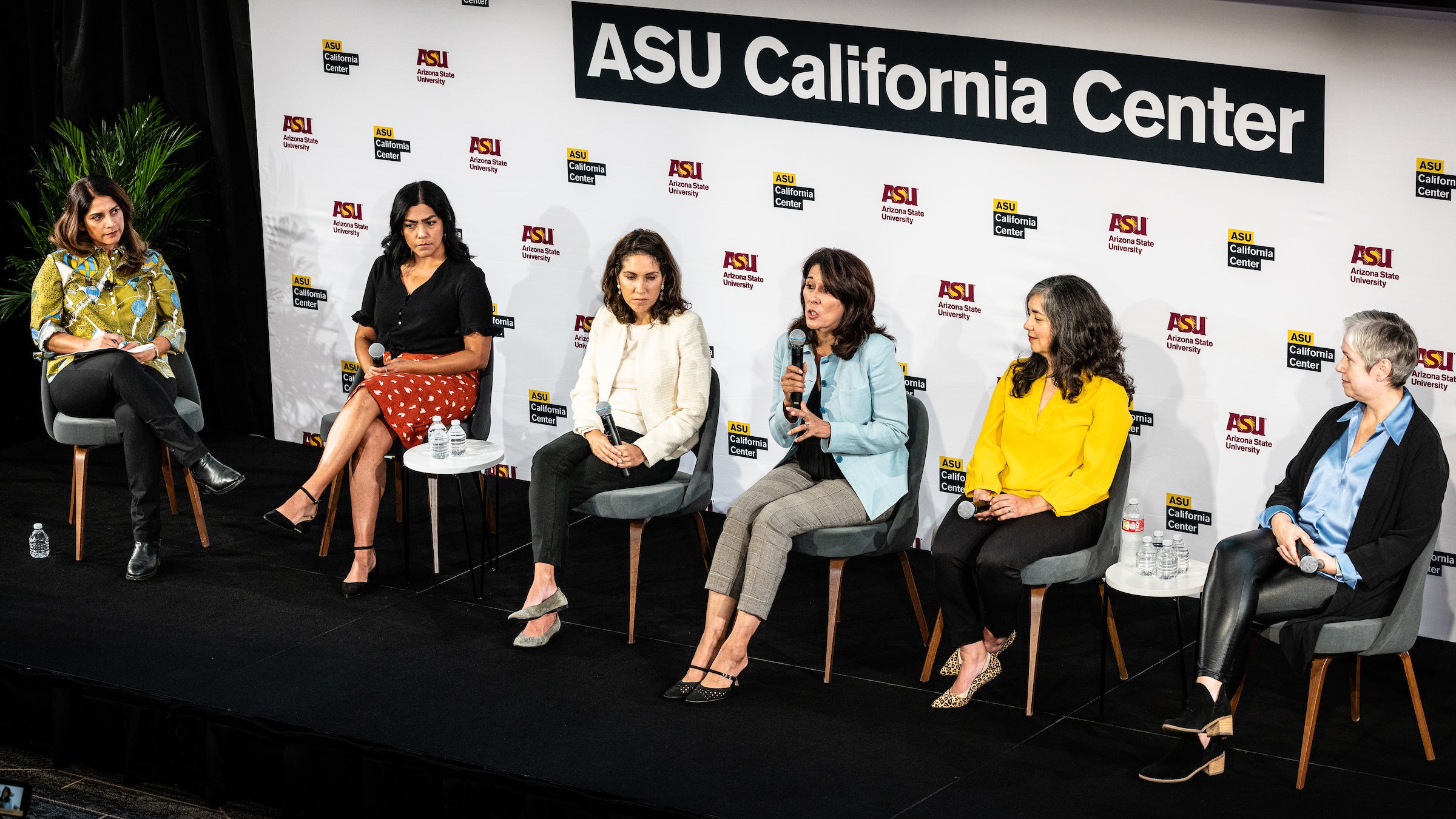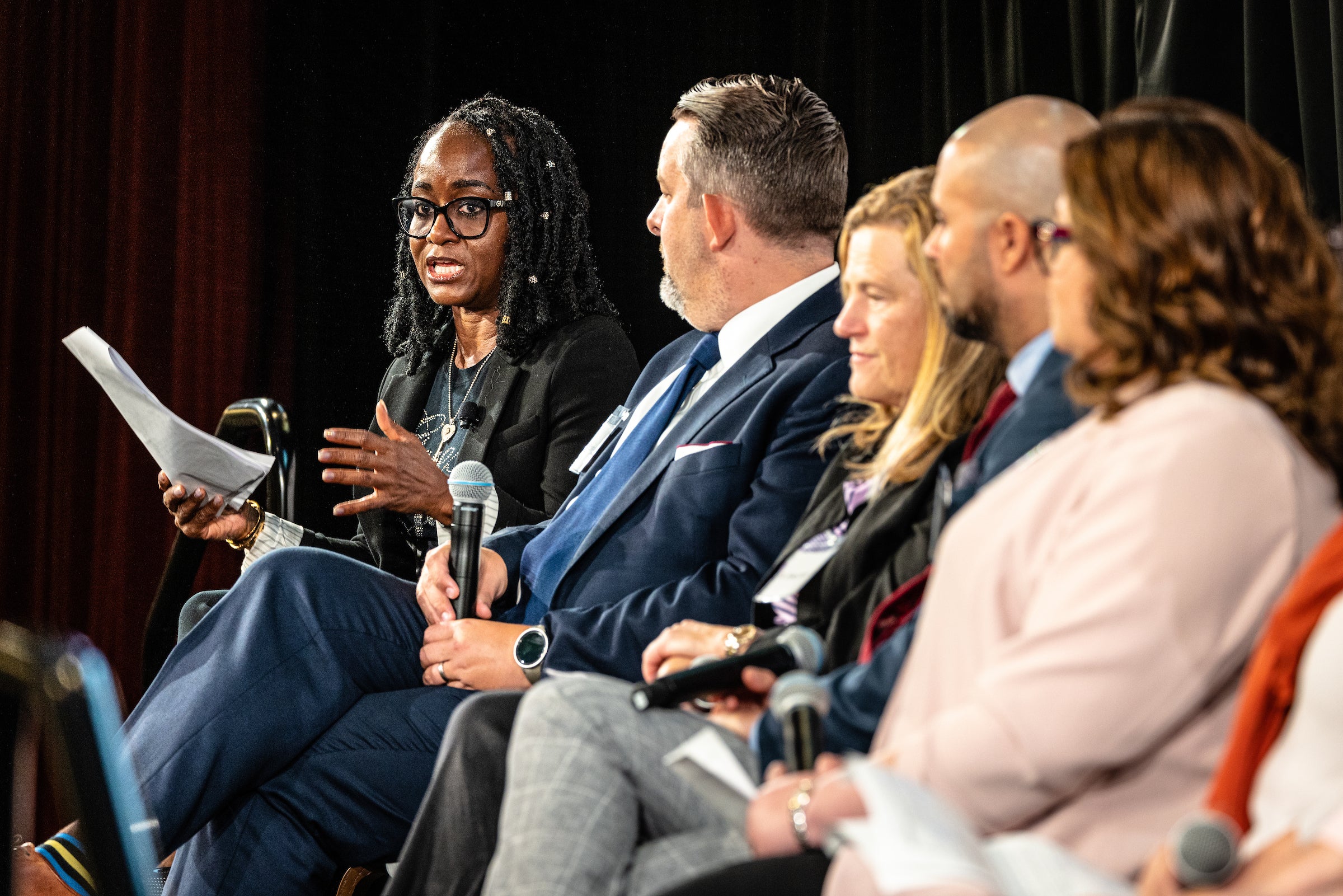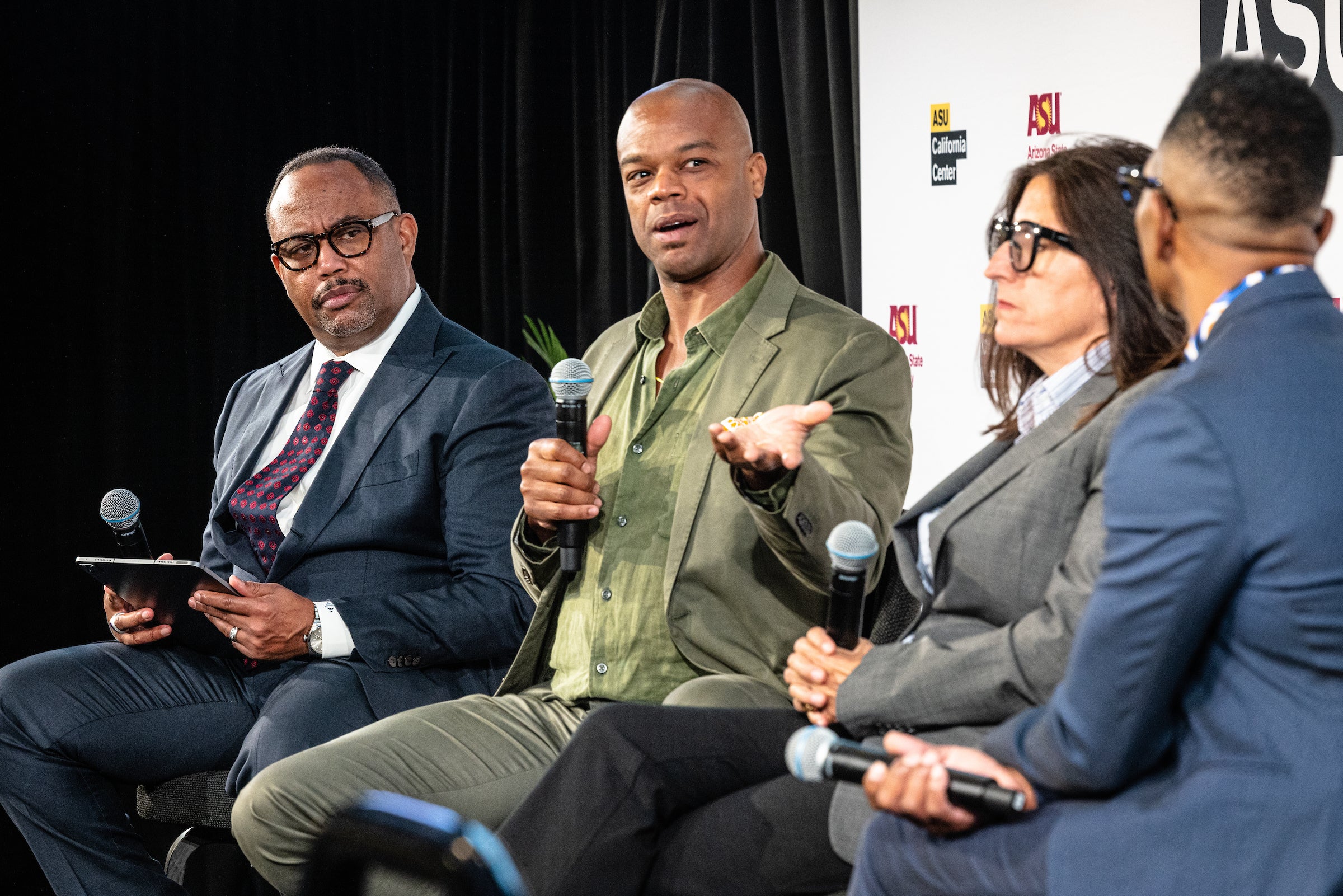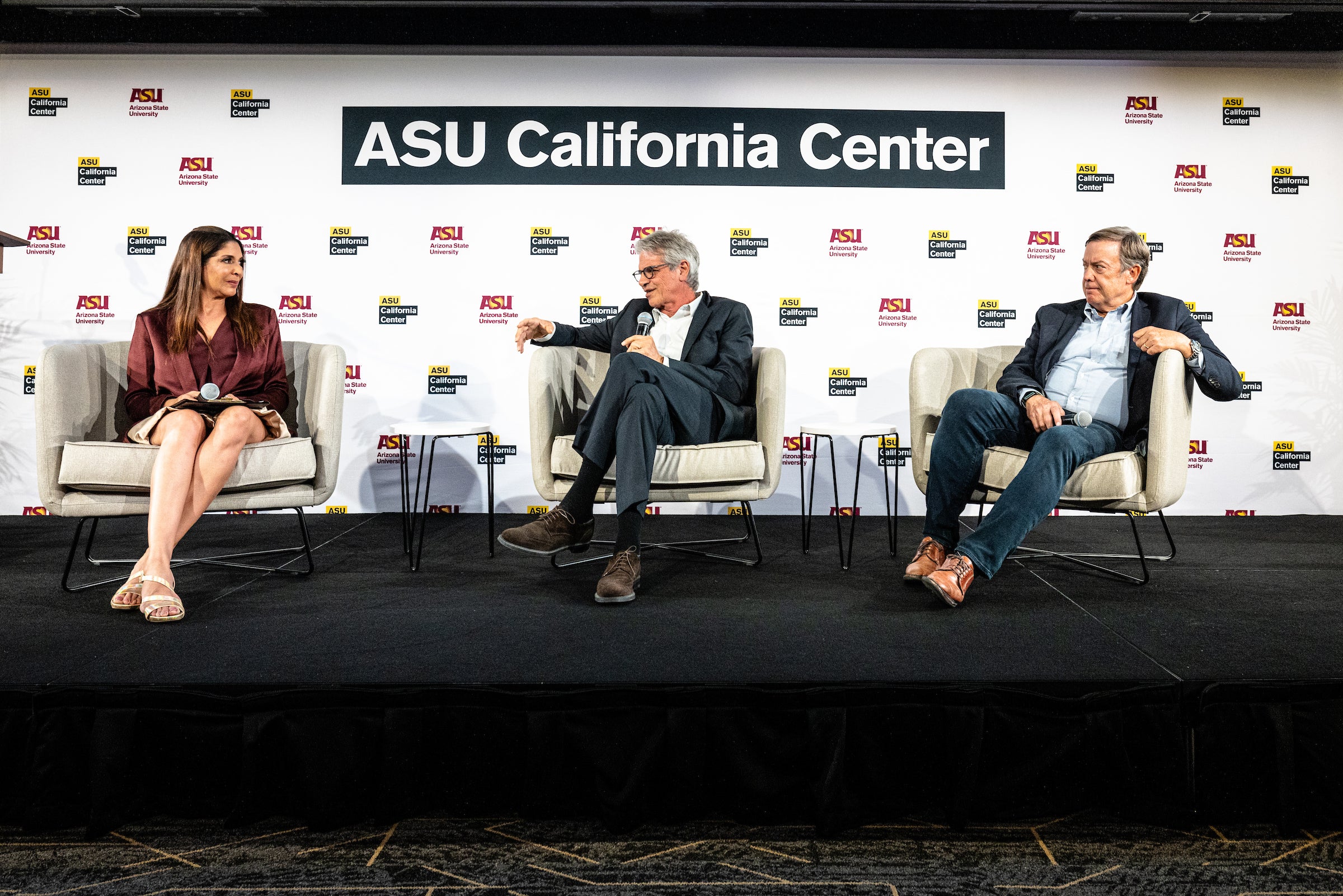Editor’s note: This story is featured in the 2022 year in review.
Editor's note: Follow along with us this week as we highlight a series of events to mark ASU's expansion in California at the ASU California Center in downtown Los Angeles.
Arizona State University is marking its expansion in California with a weeklong series of events at the ASU California Center, located at the historic Herald Examiner Building in downtown Los Angeles.
Video by Ken Fagan/ASU News
From diversity in media to opportunities in space commerce to the future of film education, the panels and discussions will explore a range of issues facing our communities. Learn more about the week's events and follow along on livestream.
ASU News is there to capture the insights and expertise shared; this blog will be updated throughout the week.
'Global Leadership in the Fourth Industrial Revolution'
5–5:45 p.m. Friday, Oct. 7
Thunderbird School of International Management alumnus Robert Grant — entrepreneur, bestselling author, prolific inventor, holder of numerous patents and founder of several corporate enterprises — talks with Thunderbird's Director General and Dean Sanjeev Khagram during the keynote address Friday, concluding the grand-opening week of the ASU California Center in downtown Los Angeles. Photo by Charlie Leight/ASU News
Robert Grant, a Thunderbird School of Global Management alumnus and the founder, chairman and managing partner of Strathspey Crown, a private equity company, said he decided to attend the Thunderbird School in the 1990s because he liked the people.
“It was very different from the Ivy League schools I visited,” Grant said Thursday evening at "Global Leadership in the Fourth Industrial Revolution," the closing keynote for the California Center's grand-opening week.
“The people were more socially aware, and that’s a distinguishing factor and why so many Thunderbird alums have ascended in organizations because they’re people you want to hang out with.”
Grant, who has lived in nine countries and learned eight languages, was drawn to a globalized experience.
“One of the things that differentiates the Thunderbird alum is that they realize that not everything they believe is the only way to see the truth,” he said.
Grant worked at several technology companies and often would start at a far-flung outpost, where he had autonomy. Then when promotion brought him back to headquarters, he was in shock at the loss of control.
“That’s when I leaned on what I learned at Thunderbird,” he said. “I had to realize that there’s another form of leadership that can be more powerful, and that’s influence.”
In a wide-ranging talk, Grant discussed how he discovered a new pattern of prime numbers, his meeting with the Dalai Lama and whether the metaverse will be an extension of human consciousness.
“Every time we have a new technology, there will an equal amount of good associated with it and an equal amount of evil,” he said.
“Maybe a core aspect of this is recognizing that the hurt of any man causes the hurt of all. It’s such an important moment right now.”
'Global and Local Sustainability: The SDGs, ESG, Climate Action and Beyond'
Noon–1:30 p.m. Friday, Oct. 7
Erin Bromaghim (center), deputy mayor of international affairs for the city of Los Angeles, speaks as Thunderbird School of International Management Director General and Dean Sanjeev Khagram (left) leads a lunchtime panel about cities and sustainability with Bromaghim and Anupam Govil, managing partner and global head of sales and strategic partnerships at Avasant, on Friday at the ASU California Center. Photo by Charlie Leight/ASU News
Cities have become major drivers toward greater sustainability, with Los Angeles among the most progressive in adopting the U.N. Sustainable Development Goals, according to Erin Bromaghim, deputy mayor of international affairs for the city of Los Angeles. She spoke at a panel Friday held by the Thunderbird School of Global Development at ASU.
“We started by trying to understand how a city can align itself and implement the goals,” she said.
Graduate students from Thunderbird helped city staff assess the city’s policies and programs and how they aligned with the goals, which aim to make communities more sustainable and equitable.
“We disaggregated the data geographically and demographically to point to specific needs in communities,” she said. “If you want an agenda where no one is left behind, you need to know where those left behind are.”
Sanjeev Khagram, director general and dean of the Thunderbird School of Global Management, said that sustainability is integrated into everything Thunderbird students do.
“It’s core to the program,” he said.
Thunderbird has partnered with the city of Phoenix on the Global Phoenix Rising initiative to help the city become more sustainable and inclusive. And in January, Thunderbird launched the Francis and Dionne Najafi 100 Million Learners Global Initiative.
“It’s 100% digital and self-paced, and it will be translated into 40 languages,” he said. “We’re building out the world’s first academic translation factory with Google, and most importantly, it’s all at no cost to the learner.”
'The Future of Film Education'
3–6 p.m. Thursday, Oct. 6
Cheryl Boone Isaacs, director and professor of practice at The Sidney Poitier New American Film School, listens during her discussion with the school's Deputy Director Peter Murrieta, which was part of "The Future of Education" event on Thursday, Oct. 6. Photo by Charlie Leight/ASU News
When Arizona State University decided to name its film school after Sidney Poitier, it was a perfect fit because the legendary actor was outspoken about the need for representation in Hollywood, and that is the mission of the The Sidney Poitier New American Film School.
“We are supporting filmmakers in front of and behind the camera,” said Cheryl Boone Isaacs, founding director of the school. She spoke at an event Thursday titled “The Future of Film Education” at the ASU California Center in downtown Los Angeles.
“Our goal at the Poitier Film School is to create as much opportunity for our students to participate in every single facet of the entertainment business, whether around production or the team that supports production, which is a vast field," she said.
Steven Tepper, dean of the Herberger Institute for Design and the Arts, said that when ASU was considering naming the film school, he approached the Poitier family, telling them that ASU’s law school is named for Sandra Day O’Connor and ASU's journalism school is named for Walter Cronkite.
“Sandra Day O’Connor, Walter Cronkite and Sidney Poitier — those are three American heroes,” he said.
“Those are three people who embody dignity, statesmanship and excellence at the highest levels.”
>> MORE: Read the full story
'Space Exploration, Commerce and Stewardship'
8:30 a.m.–noon Thursday, Oct. 6
Professor of Practice Cady Coleman, ASU’s global explorer-in-residence, chats with fellow former NASA astronaut Garrett Reisman during a session on “Space Exploration, Commerce and Stewardship” on Oct. 6 at the ASU California Center. Photo by Charlie Leight/ASU News
Former NASA astronaut Cady Coleman said that space travel and the space industry need diversity to succeed.
“We’re not going to be successful if we only have people who look and think alike,” said Coleman, who is the ASU global explorer-in-residence at the School at Earth and Space Exploration.
She’s been working with a group that is seeking to make space accessible to people with disabilities.
“It was eye opening to realize that I’ve been leaving a slew of the population out of my thoughts and ideas,” she said.
“These people are problem-solvers before they get out of bed in the morning. I want to go to space with a problem-solver.”
Coleman's remarks were followed by a panel discussion on industry outlooks for our future in space.
The nature of the public-private partnerships and the increase in commercial space travel has changed the industry, according to Jim Bell, professor in the School of Earth and Space Exploration and director of the Space Technology and Science (NewSpace) Initiative.
“Our traditional aerospace partners are still there and still involved,” such as Lockheed Martin, he said. “But the new landscape is chock full of entrepreneurial, disruptive small companies that have great ambition and are being seeded with funding by the government.”
Instead of once-in-a-decade, billion-dollar missions, several smaller missions to the moon, Earth orbit and commercial space stations are planned, Bell said.
>> MORE: Read the full story
'From Ground to Galaxy: How Universities Are Reinventing the World at Large'
Noon–1 p.m. Tuesday, Oct. 4
ASU Provost Nancy Gonzales (center) speaks at the "From Ground to Galaxy" panel on Tuesday, Oct. 4. The panel discussion was moderated by Moira Shourie (left), executive director of ASU’s Zócalo Public Square. Also pictured: Lina Calderon-Morin, deputy director of the Southern California College Access Network; Maria Anguiano, executive vice president of ASU’s Learning Enterprise; Elizabeth González, chief program and strategy officer of California’s College Futures Foundation; and Lindy Elkins-Tanton, Foundation Professor and Regents Professor with ASU’s School of Earth and Space Exploration and vice president of the ASU Interplanetary Initiative. Photo by Charlie Leight/ASU News
To serve everyone in their communities — from pre-school students to retirees — universities must evolve into new kinds of institutions, a goal that Arizona State University has been pursuing, according to Nancy Gonzales, provost and executive vice president of the ASU Academic Enterprise.
“We’ve redesigned ourselves to take advantage of many opportunities, and it’s done in nontraditional ways — in partnership with other universities and in partnership with industry, government and private philanthropy,” she said.
Maria Anguiano, executive vice president of the ASU Learning Enterprise, said that ASU wants to impact people across the life span.
“The Learning Enterprise was created to plug into learning as early as possible and work with community partners and K–12 to figure out those gaps,” she said.
“The idea of continuous knowledge is important,” she said. “How do we get people to have educational pathways to thrive in life?”
One innovation is ASU’s degree in technological leadership, which can be earned in three years, according to Lindy Elkins-Tanton, Foundation Professor and Regents Professor in the School of Earth and Space Exploration and vice president of the ASU Interplanetary Initiative.
“We have a way to train people to ask better questions. We want them to notice the things unsolved and have the skills to solve them,” she said.
'Beyond State Lines: Creating a Culture of Transfer'
11–11:45 a.m. Tuesday, Oct. 4
Moderator Cheryl Hyman (left), vice provost of Academic Alliances at ASU, poses a question to panelists on Tuesday, Oct. 4, during the “Beyond State Lines: Creating a Culture of Transfer” panel. Photo by Charlie Leight/ASU News
Higher education institutions need to think beyond expanding access to college and focus on success throughout the journey toward graduation and a good job, according to a panel of experts who spoke Tuesday morning.
“Most learners don’t follow a linear path,” said Cheryl Hyman, vice provost for academic alliances at ASU, who moderated the discussion titled “Beyond State Lines: Creating a Culture of Transfer.”
“Many attend more than one academic institution, and 40% start at community colleges,” she said.
Technology is one way to help facilitate transfer.
“It’s difficult for individual students to understand how their credits apply to any particular program in a particular institution,” said Rasmus Lynnerup, assistant vice provost for Academic Alliances at ASU. “The only way forward is to develop technology that allows for reduced complexity and opacity, and puts the agency back with the learner."
Creating a common course-numbering system is the “holy grail” of higher education, according to Erika Endrijonas, superintendent-president of Pasadena City College. But in California, courses are the purview of faculty, who have resisted attempts to unify numbers, so the same course has different numbers at colleges in the same district.
Common course numbering “would be one of the most impactful ways for us to facilitate ease of transfer to ASU and other places,” she said.
'The Next Normal: Galvanizing Educators, Communities and Technology Around P–12 Learners'
9–10:30 a.m. Tuesday, Oct. 4
ASU has created a new kind of team-teaching model that’s intended to improve student learning but also empower teachers to leverage their expertise.
“A lot of people say there’s a teacher shortage,” said Lisa Cannon, senior program manager for the Next Education Workforce Initiatives at ASU’s Mary Lou Fulton Teachers College.
“That isn’t new. But what if we don’t look at it as a teacher shortage but as a workforce design model problem?”
Cannon spoke at a panel discussion Tuesday morning titled “The Next Normal: Galvanizing Educators, Communities and Technology Around P–12 Learners."
“If you think about one teacher and one classroom, it’s all the expectations we have for that one human being. We expect them to know all the latest and greatest and have all the pedagogical skills and meet the needs of all students,” she said.
In the team model, educators of varying levels of experience, background and expertise work with larger groups of students. A longtime, National Board Certified teacher who’s good at teaching reading might work with a new teacher whose background is in social media and a math specialist who used to be an engineer.
“So we look at a team-based model to provide deeper, personalized learning, so kids have access to multiple adults and learn off multiple kinds of expertise,” Cannon said.
>> MORE: Read the full story
'Diversity, Culture and Media'
6–8 p.m. Monday, Oct. 3
Malcolm Venable, a senior staff writer at Shondaland, speaks during the “Diversity, Culture and the Media” panel Monday at the ASU California Center in Los Angeles. The event also featured (from left) Cronkite School Dean Battinto Batts Jr.; Nonny de la Peña, a Peabody winner and ASU faculty member; and Ron Kellum, a Cronkite School alum and producer and director. Photo by Charlie Leight/ASU News
In a discussion on “Diversity, Culture and the Media” on Monday evening at the Herald Examiner Building, Walter Cronkite School of Journalism and Mass Communication Dean and event moderator Battinto Batts Jr. noted that newsrooms have not become significantly more representative since he started in the business decades ago.
“I would not be here if it was not for efforts at diversity. But since then, we’re running in place,” he said.
The lack of diversity has meant a lack of role models, according to Nonny de la Peña, the founding director of the Narrative and Emerging Media Program at ASU. She is the founder and CEO of Emblematic Group, a digital media company focused on immersive virtual, mixed and augmented reality.
“In technology, it’s a monoculture,” she said. “It’s one of the reasons I’m here (at ASU). I was running my company, and I would pull in an intern here or there and I was never going to really disrupt that monoculture.”
All three panelists — de la Peña; Malcolm Venable, an entertainment journalist and currently a senior writer for Shondaland.com; and ASU alum Ron Kellum, a producer and director who was the the first African American artistic director for Cirque du Soleil — noted the burden that is inherent with being the “first” or the “only” in the room.
“Being first is framed as an achievement, but we should reframe it as a failure of the organization,” Venable said. “What happened to eliminate all the other qualified people?”
>> MORE: Read the full story
'Mission + City + Architecture: ASU and the Revitalized Herald Examiner Building'
Noon–2 p.m. Monday, Oct. 3
Linda Dishman (second from right), president and CEO of the Los Angeles Conservancy, speaks during the panel “Transition: Mission + City + Architecture” panel on Monday, Oct. 3, held in the historic Herald Examiner Building, now home to the ASU California Center. Also pictured, from left to right: panel moderator Duke Reiter, American Institute of Architects fellow, senior advisor to the president at ASU and executive director of ASU's University City Exchange; Melanie McArtor, senior associate with design and architecture firm Gensler; Barbara Bouza, American Institute of Architects fellow and president of Walt Disney Imagineering; and Karen McNeill, a Julia Morgan scholar and member of the Board of Trustees of the Beverly Willis Architecture Foundation. Photo by Charlie Leight/ASU News
A newspaper story announcing the completion of the new Herald Examiner Building in 1914 noted that it was designed by Julia Morgan, “who, although a woman, stands in the front ranks of architects in the country.”
Karen McNeill, a historian, discussed Morgan at a program Monday titled “Mission + City + Architecture: ASU and the Revitalized Herald Examiner Building.” The program was organized, hosted and moderated by Duke Reiter, senior advisor to the president at ASU and executive director of University City Exchange.
Morgan was the first woman licensed as an architect in California, in 1904. Nine years later, William Randolph Hearst hired her to design and build the largest newspaper building in the country.
“It was a massive project that she managed from 340 miles away,” McNeill said.
The Herald Examiner closed in 1989, and the building sat vacant. In 1991, the building was threatened with demolition, according to Linda Dishman, president and CEO of the Los Angeles Conservancy, which helped to acquire protections for the site, paving the way for renovation.
“The Hearst family decided to see how hard it would be to get a demolition permit,” Dishman said. “It was hard because the city told everybody.
“We had to do a lot of explanation of why it was important to save the original McDonald’s, but on the Herald Examiner Building, people got it.”
The Hearst Corp. decided to put the demolition on hold, using the building as a filming location to generate some income.
Chris Hawthorne, chief design officer for the city of Los Angeles, once wrote that the building was the most important shuttered building in LA.
“It’s important to think of this building and Julia Morgan in the context of the LA architecture that followed, particularly the civic monuments that looked to this building as an early example of a quintessentially Los Angeles skill of achieving a kind of eclecticism or marriage of styles and period influences,” he said. Other examples include the Central Library and Union Station.
Melanie McArtor, a senior associate for Gensler and project manager for the renovation of the building, began work in 2015. All the skylights had been painted over after Pearl Harbor was bombed in 1941, and all the arched windows were cemented over after labor riots in the 1960s. The building had been vacant since the 1989 shuttering of the newspaper.
“Because it was used as a filming location, there were many layers that needed to be peeled back,” she said.
“Having ASU as the lead tenant is so exciting because it brings journalism back to the buildingThe Walter Cronkite School of Journalism and Mass Communication is one of the ASU units with a presence in the building, including a Cronkite News bureau.,” Dishman said. “But it also opens it to the community, and there’s so much affection for this building, especially the lobby, that it comes with a lot of good will.”
Video by Ken Fagan/ASU News
'Is LA Still a Global City?'
8:30–10 a.m. Monday, Oct. 3
Los Angeles Mayor Eric Garcetti spoke at an event on Monday morning called “Is LA Still a Global City?” Garcetti said that the important question for Los Angeles is: "What kind of global city are we?"
“Nothing about being global inherently makes you a fair city or a just city. It just makes you big,” he said.
Los Angeles, where 63% of the residents are immigrants or the children of immigrants, is at the crossroads of many of the world’s biggest industries, including not only the entertainment industry but also fashion, fine arts and new media, he said.
“We are the shot callers, the investors, the storytellers. Part of that is our universities, like ASU, which we welcome as an LA university joining the other great institutions,” Garcetti said.
A panel discussion followed Garcetti’s talk, in which ASU President Michael Crow emphasized the need for cities to maintain a vibrant urban core.
“We’re here because this is the place where the future is being outlined,” he said.
>> MORE: Read the full story
Using Hollywood storytelling in education
Fireside chat, the evening of Sunday, Oct. 2
Following a cocktail reception and dinner, Fox 11 Los Angeles news anchor and ASU alumna Christine Devine moderates a discussion with ASU President Michael Crow (right) and Walter Parkes, co-founder and CEO of Dreamscape Immersive, on Sunday, Oct. 2, at the launch of the ASU California Center in Los Angeles. Photo by Charlie Leight/ASU News
ASU kicked off a week of events celebrating the new ASU California Center in downtown Los Angeles with a discussion about how ASU is using the storytelling expertise of Hollywood to change the nature of education.
ASU President Michael Crow and Hollywood producer, screenwriter and media executive Walter Parkes described the Dreamscape Learn technology platform to a group of ASU alumni who gathered for a dinner at the Herald Examiner Building — the new home of the ASU California Center — on Oct. 2.
“One reason for being in California is that there are so many geniuses and so much creativity, and part of being innovative is accepting that we can’t do everything,” Crow said. “We should focus on people who can do the things we can’t do.”
Crow asked the crowd if they’ve every cried in a movie.
“How is this possible? You don’t even know these people,” he said. “Who’s cried in a biology class? Nobody.
“Hollywood is genius storytelling that connects you to your emotions.”
Parkes, co-founder and CEO of Dreamscape Learn, said that after a long career of engaging people in entertainment, he realized those capabilities should be transferrable to education.
About 3,000 ASU students are learning biology with Dreamscape Learn this semester, in which they have virtual reality experiences with a headset, hand sensors and desktop controls. They feel vibrations in their chairs as they “travel” to an intergalactic wildlife sanctuary and use the joystick to control actions such as a creature dissection.
“We said maybe we can use this narrative approach and technology to transform students into scientists and allow them to go into the interstellar wildlife sanctuary and actually solve problems with others,” Parkes said.
Top photo: Guests mingle in the lobby of the Herald Examiner Building in downtown Los Angeles on Sunday, Oct. 2, at the grand opening of the ASU California Center. Photo by Charlie Leight/ASU News
More Law, journalism and politics

Annual John P. Frank Memorial Lecture enters its 26th year
Dahlia Lithwick, an MSNBC analyst and senior legal correspondent at Slate, is the featured speaker at the School of Social Transformation’s 26th annual John P. Frank Memorial Lecture on…

The politics behind picking a romantic partner
A new study reveals the role that politics play when picking out a romantic partner — particularly for older adults.“Findings show that politics are highly salient in partner selection across gender…

Tips to make tax season less taxing
When it comes to highly unpleasant experiences, filing taxes is probably up there with root canals — which is why people put off doing them. But tax season is here, and in an effort to alleviate…


